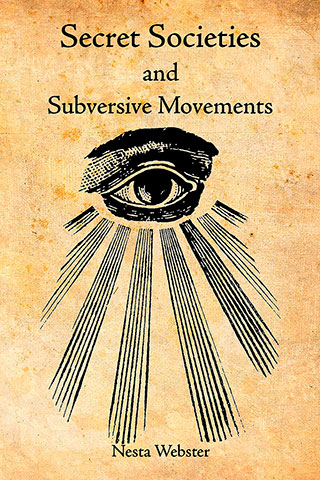Animal Telepathy: Skeptic Controversies
Dogs That Know When Their Owners Are Coming Home 7,109 views
October 25, 2013
 The topics discussed in this book are considered taboo by some members of the scientific world. The very ideas of telepathy, an unexplained sense of direction, premonitions, or precognitions arouse skepticism, if not hostility, among some scientists and philosophers. Why?
The topics discussed in this book are considered taboo by some members of the scientific world. The very ideas of telepathy, an unexplained sense of direction, premonitions, or precognitions arouse skepticism, if not hostility, among some scientists and philosophers. Why?
My research has led me into a series of intense controversies. People with no experience of professional science may imagine that it is all about the open-minded exploration of the unknown, but this is rarely the case. Science works within frameworks of belief or models of reality. Whatever does not fit in is denied or ignored; it is anomalous. The historian of science Thomas Kuhn called these thought-patterns paradigms. During periods of what he called normal science, scientists work within the paradigm and ignore or deny anomalies.
In scientific revolutions orthodox paradigms are challenged and replaced with new, larger models of reality that can incorporate previously rejected anomalies. In due course these new thought patterns become standard orthodoxies.
The paradigm that has dominated institutional science since the nineteenth century is materialism: Matter is the only reality. Mind or consciousness exists only insofar as it arises from material processes in brains. Animals — and people — are nothing but complex machines, expicable in terms of the ordinary laws of physics and chemistry. Minds are inside brains and cannot have mysterious effects at a distance.
Ironically, although materialists put their faith in physical laws, these laws are not themselves physical. They are conceived of as nonmaterial principles that transcend space and time, potentially active at all times and in all places. Moreover, several modern physicists have pointed out that nothing in modern physics — as opposed to nineteenth-century physics — would be compromised by the existence of abilities such as telepathy. In the light of quantum theory, the laws of classical physics have been rewritten.

For most believers in materialism, God is nothing but a delusion inside human minds, and hence inside heads. People with a strong materialist faith are usually atheists as well. Atheists are not people without a belief; they are people with a strong faith in the doctrine of materialism. From their point of view religious beliefs are nonsensical and so are psychic phenomena. During what is somewhat arrogandy called the Enlightenment, the materialism and determinism of classical science gave intellectuals the tools to challenge the authority of church and scripture with the authority of science. Modern secular humanists are the direct descendants of the Enlightenment thinkers, and their worldview is for the most part still based on the materialism implied by classical physics. If materialism is falsified by the data for telepathy and other psychic phenomena, then one of the foundations of their opposition to religion is thereby removed. Hence the vehement denial of any evidence for the existence of phenomena that go against their beliefs.
Regardless of what materialists think, most people believe that they have had telepathic experiences, often in connection with telephone calls, by thinking of someone who then calls. Many owners of dogs, cats, horses, parrots, and other animals find their animals pick up their thoughts and intentions. Some scientists have telepathic experiences themselves, and some have dogs that know when they are coming home from the laboratory. But scientists usually keep quiet about these experiences. At work they function within a materialist paradigm; in their private lives many are religious, or follow spiritual paths, or think there is more in heaven and earth than is dreamed of in the materialist philosophy. Only a minority are card-carrying atheists.
Not all atheists are opposed to research on psychic phenomena. Sam Harris, author of The End of Faith, is open to the possibility that some of these phenomena may be real. Meanwhile several eminent parapsychologists are atheists. They hope that psychic phenomena can be incorporated into an enlarged scientific model of reality. I share that hope, although I am not an atheist myself.
Unfortunately, much passion arises because materialists feel that science and reason themselves are being threatened by acknowledging the existence of psychic phenomena. But that is only the case if science is identified with old-style materialism. There is an alternative scientific possibility: Psychic phenomena are compatible with an expanded scientific model of reality and are independent of the question of the existence of God. Psychic phenomena like telepathy are natural, not supernatural. They no more prove or disprove the existence of God than do the sense of smell or the existence of electromagnetic fields.
Skepticism
Genuine skepticism is healthy and an integral part of science. Scientists in all areas of professional research are subjected to institutionalized skepticism in the form of anonymous peer review. Whenever they submit a paper to a scientific journal, the editor sends it to two or more referees, often the authors’ competitors or rivals, whose names are not revealed to the author. This is normal scientific practice, and I am used to it after publishing more than eighty papers in peer-reviewed journals. Grant proposals are often peer-reviewed as well.
However, another kind of skepticism comes into play in relation to taboo topics like telepathy — the dogmatic skepticism of people defending a belief system or orthodoxy. The more militant the skeptic, the more passionate the belief.
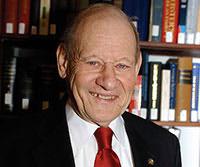
When Paul Kurtz announced the change of name from CSICOP to CSI in the January 2007 Skeptical Inquirer, he looked back over CSICOP’s past and made it clear that the organization’s agenda was rooted in an ideological commitment: “We viewed ourselves as the defenders of the Enlightenment.” In an interview for Science magazine, Lee Nisbet, the CSICOP Executive Director, put it as follows: “[Belief in the paranormal is] a very dangerous phenomenon. Dangerous to science, dangerous to the basic fabric of our society. … We feel it is the duty of the scientific community to show that these beliefs are utterly screwball.” As is the case with so many of the leading figures in CSICOP/CSI, Nisbet has no scientific qualifications.
CSICOP/CSI’s primary efforts are directed to influencing public opinion. The Skeptical Inquirer carries innumerable articles decrying the media’s treatment of the paranormal and describes CSICOP’s attempts to combat any favorable coverage. As reported in the Skeptical Inquirer, CSICOP originated “to fight mass-media exploitation of supposedly ‘occult’ and ‘paranormal’ phenomena. The strategy was two-fold: First, to strengthen the hand of skeptics in the media by providing information that ‘debunked’ paranormal wonders. Second, to serve as a ‘media-watchdog’ group that would direct public and media attention to egregious media exploitation of the supposed paranormal wonders. An underlying principle of action was to use the main-line media’s thirst for public-attracting controversies to keep our activities in the media, hence in the public eye. Who thought this strategy up? Well, Paul Kurtz, that’s who.”
In a penetrating essay called “The Skepticism of Believers,” published in 1893, Sir Leslie Stephen, a pioneering agnostic (and the father of the novelist Virginia Woolf), argued that skepticism is inevitably partial. “In regard to the great bulk of ordinary beliefs, the so-called skeptics are just as much believers as their opponents.” Then as now, those who proclaim themselves skeptics had strong beliefs of their own. As Stephen put it, “The thinkers generally charged with skepticism are equally charged with an excessive belief in the constancy and certainty of the so-called laws of nature. They assign a natural cause to certain phenomena as confidendy as their opponents assign a supernatural cause.”
Almost all the people who have attacked me as a result of the research with animals described in this book have been Fellows of CSICOP, militant atheists, or career skeptics, not professionals who actually know about animals: researchers in animal behavior, animal trainers, or vets. I have given seminars in veterinary schools and lectured at academic conferences on companion animals (the academic term for pets) to audiences who seemed genuinely interested in the studies described in this book. I have spoken on this research in dozens of university science and psychology departments; to student science societies; at international scientific conferences; to scientific institutes, including the European Molecular Biology Laboratory, in Heidelberg, Germany; at international conferences on consciousness studies; and to corporations like Microsoft, Nokia, and Google. (My technical seminar at Google is online on the Google website.) Of course some of the people at these events have been skeptical, but again and again I have found that dogmatic skeptics are a small minority. They often claim to speak for the scientific community, but fortunately most scientists are more open-minded.
Here is a summary of some of my encounters.
Sir John Maddox, editor of Nature
The late Sir John Maddox, one of CSICOP’s most eminent Fellows, was my longest-standing critic. As the editor of Nature, the prestigious scientific journal, he was the author of an infamous Nature editorial about my first book, A New Science of Life, in which he wrote, “This infuriating tract … is the best candidate for burning there has been for many years.” In an interview broadcast on BBC television in 1994 he said, “Sheldrake is putting forward magic instead of science, and that can be condemned in exactly the language that the Pope used to condemn Galileo, and for the same reason. It is heresy.”
Maddox reviewed Dogs That Know When Their Owners Are Coming Home in Nature in October 1999. This is how he began: “Rupert Sheldrake is steadfastly incorrigible in the particular sense that he persists in error. That is the chief import of his eighth and latest book. Its main message is that animals, especially dogs, use telepathy in routine communications. The interest of this case is that the author was a regular scientist, with a Cambridge Ph.D. in biochemistry, until he chose pursuits that stand in relation to science as does alternative medicine to medicine proper.”
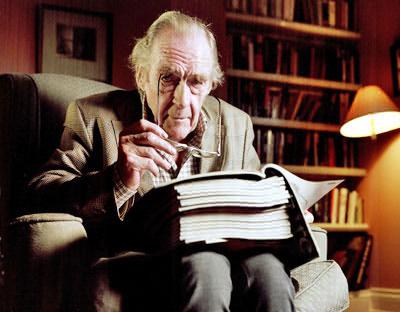
By conceding that the data gathered during these observations are statistically significant, one does not sign up for Sheldrake’s interpretation that the underlying mechanism is dog-Homo telepathy. Too many variables are uncontrolled. Did the accuracy of anticipation vary with the length of time elapsed since Pam’s departure (suggesting that the dog used its sense of the passage of time to signal its sense of when return was due)? Were there people in the room with the dog (allowing them to communicate somehow with the eager waiter)? And while Jaytee appears to have been chosen for videotaping as a result of his acumen in earlier trials, does not the interpretation of his behavior require an understanding of the variability of dogs’ capacity for anticipation in general?
Maddox concluded his review as follows:
Especially because people’s fondness for their pets often takes the form of projecting onto them human or even superhuman perceptiveness, even more than 1,000 records on the Sheldrake website do not prove telepathy. I doubt that Sheldrake will take the point. He makes plain his distaste for what he calls orthodox science, which is “all too often equated with a narrow-minded dogmatism that seeks to deny or debunk whatever does not fit in with the mechanistic view of the world.” He is habitually courteous and cheerful, but holists of his ilk would not dream of letting controls get in the way of revealed truth.
I wrote to Maddox taking up the scientific points he raised, starting with his suggestion that Jaytee used the passage of time to signal when Pam was returning. I pointed out, “The longer the absence, the longer the time the dog took to start waiting at the door when Pam was on her way home. A statistical analysis comparing the long, medium, and short experiments ruled out the passage of time argument. So did the control experiments carried out when Pam was not coming home. So I think this question is already answered by the data.”
Maddox’s second question was about people in the room with the dog. I wrote, “As I make clear in my account, in experiments at Pam’s parents’ flat, her parents were in the room, but since they did not know when she was coming home, especially in the experiments with randomized return times, the only way they could have communicated this information to her would be if they themselves picked up telepathically when she was on her way. In experiments at Pam’s sister’s house, her sister was present, but again only a person-to-person telepathy argument would provide a real alternative explanation. And then we carried out fifty experiments with the dog alone in Pam’s flat. He still showed his reactions to a statistically significant extent when completely alone.”
The third question about the variability for dogs’ capacity for anticipation in general was obscure, or at least too vague to answer, though I had much data on dogs’ anticipatory behavior in general. I ended my letter to Maddox as follows:
In your final remark you say, “Holists of his ilk would not dream of letting controls get in the way of revealed truth.” If you mean other unspecified persons, then it is meaningless and irrelevant. If you mean me, then what you say is unjust and untrue. I have done thousands of experiments over the years involving controls, as you can see by looking at my many published papers. And of course I use controls in my research with animals. I have never regarded animal telepathy as revealed truth; it is certainly no article of faith for any religion, nor is it even mentioned in most books on parapsychology. I entered this field of inquiry with an open mind about what animals can and cannot do, and would not otherwise have spent years in empirical investigations of their abilities.
Maddox did not reply, although when I met him several months later at a seminar at the Royal Society, he said, “I ought to have replied to your letter but I haven’t got ’round to it.” He died in 2009 and never got ’round to it.
James “The Amazing” Randi
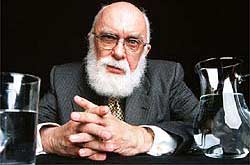
In 1996 he founded the James Randi Educational Foundation (JREF) and is most famous for offering a million-dollar paranormal challenge to anyone who can demonstrate evidence of a paranormal event under conditions to which he agrees. Randi has no scientific credentials and has disarmingly said of himself, “I’m a trickster, I’m a cheat, I’m a charlatan, that’s what I do for a living.”
In January 2000 Dog World magazine published an article on the sixth sense of dogs, which discussed my research. The author contacted Randi to ask his opinion. Randi was quoted as saying that in relation to canine ESP, “We at the JREF have tested these claims. They fail.” Randi also claimed to have debunked one of my experiments with Jaytee, in which Jaytee went to the window to wait for his owner when she set off to come home at a randomly selected time but did not go to the window before his owner left to come home. In Dog World Randi stated, “Viewing the entire tape, we see that the dog responded to every car that drove by and to every person who walked by.”
I e-mailed James Randi to ask for details of this JREF research. He did not reply. He ignored a second request for information. I then asked members of the JREF Scientific Advisory Board to help me find out more about this claim. They advised Randi to reply.
In an e-mail on February 6, 2000, Randi told me that the tests with dogs he referred to were not done at the JREF but took place “years ago” and were “informal.” He said they involved two dogs belonging to a friend of his that he observed over a two-week period. All records had been lost. He wrote: “I overstated my case for doubting the reality of dog ESP based on the small amount of data I obtained.”
I also asked him for details of the tape he claimed to have watched, so I could compare his observations of Jaytee’s behavior with my own. He was unable to give a single detail, and under pressure from the JREF Advisory Board he had to admit that he had never seen the tape. His claim was a lie.
For many years the million-dollar prize has been Randi’s stock-in-trade as a media skeptic, but even other skeptics are skeptical about its value as anything but a publicity stunt. For example, CSICOP founding member Dennis Rawlins pointed out that Randi acts as “policeman, judge, and jury,” and he quoted him as saying, “I always have an out.” Ray Hyman, a professor of psychology and Fellow of CSICOP, pointed out this “prize” cannot be taken seriously from a scientific point of view: “Scientists don’t settle issues with a single test, so even if someone does win a big cash prize in a demonstration, this isn’t going to convince anyone. Proof in science happens through replication, not through single experiments.”
Nevertheless I asked the Smart family if they would be willing to have Jaytee tested by Randi. But they wanted nothing to do with him. Jaytee had already taken part in some tests organized by a skeptic, Richard Wiseman, as discussed below, and the Smart family was disgusted by the way he had misrepresented these tests in the media.
In 2008 Alex Tsakiris, who runs a U.S.-based Open Source Science Project and a podcast called Skeptiko, started replicating experiments with dogs that knew when their owners were coming home, posting videos of tests on the Internet. Tsakiris asked Dr. Clive Wynne, an expert on dog behavior at the University of Florida, to participate in this research, and Wynne agreed. Randi challenged Tsakiris to apply for the million-dollar challenge; Tsakiris took him up on it and asked Randi by e-mail if Dr. Wynne’s involvement was acceptable to him. Randi eventually replied, “You appear to think that your needs are uppermost on my schedule. What would give you that impression? Looking into a silly dog claim is among my lowest priority projects. When I’m prepared to give you some time, I’ll let you know. There are some forty-plus persons ahead of you.”
For me the most surprising feature of the Randi phenomenon is that so many journalists and fellow skeptics take him seriously.
Richard Wiseman
Richard Wiseman started his career as a conjurer and like Randi is a skilled illusionist. He has a Ph.D. in psychology and is an expert on the psychology of deception. He is a Fellow of CSICOP/CSI, one of Britain’s best-known media skeptics, and is currently Professor of the Public Understanding of Psychology at the University of Hertfordshire.
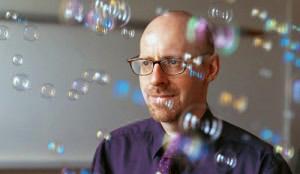
As in my own experiments, Jaytee sometimes went to the window at other times — for example, to bark at passing cars — but he was at the window far more when Pam was on her way home than when she was not. In the three experiments Wiseman did in Pam’s parents’ flat, Jaytee was at the window an average of 4 percent of the time during the main period of Pam’s absence and 78 percent of the time when she was on the way home. This difference was statistically significant. When Wiseman’s data were plotted on graphs they showed essentially the same pattern as my own. In other words Wiseman replicated my own results.
I was astonished to hear that in the summer of 1996 Wiseman went to a series of conferences, including the World Skeptics Congress, announcing that he had refuted the psychic pet phenomenon. He said Jaytee had failed his tests because he had gone to the window before Pam set off to come home. In September 1996 I met Wiseman and pointed out that his data showed the same pattern as my own, and that far from refuting the effect I had observed his results confirmed it. I gave him copies of graphs showing my own data and the data from the experiments that he and Smith conducted with Jaytee. But he ignored these facts.
Wiseman reiterated his negative conclusions in a paper in the British Journal of Psychology, coauthored with Smith and Julie Milton, in August 1998. This paper was announced in a press release entitled “Mystic dog fails to give scientists a lead,” together with a quote from Wiseman: “A lot of people think their pet might have psychic abilities, but when we put it to the test what’s going on is normal not paranormal.” There was an avalanche of skeptical publicity, including newspaper reports with headlines like “Pets have no sixth sense, say scientists” (The Independent, August 21) and “Psychic pets are exposed as a myth” (The Daily Telegraph, August 22). Smith was quoted as saying, “We tried the best we could to capture this ability and we didn’t find any evidence to support it.” The wire services reported the story worldwide. Skepticism appeared to have triumphed.
Wiseman continued to appear on TV shows and in public lectures claiming he had refuted Jaytee’s abilities. Unfortunately, his presentations were deliberately misleading. He made no mention of the fact that in his own tests Jaytee waited by the window far more when Pam was on her way home than when she was not, nor did he refer to my own experiments. He gave the impression that my evidence was based on one experiment filmed by a TV company, rather than on more than two hundred tests, and he implied that he has done the only rigorous scientific tests of this dog’s abilities.
Instead of plotting their data on graphs and looking at the overall pattern, Wiseman, Smith, and Milton used a criterion of their own invention to judge Jaytee’s success or failure. They did not discuss this criterion with me, although I had been studying Jaytee’s behavior in detail for more than a year before I invited them to do their own tests. They instead based their findings on remarks about Jaytee’s behavior made by commentators on two British television programs, who said that Jaytee went to the window every time that his owner was coming home, when in fact he did so on 86 percent of the occasions. And one of these programs said that Jaytee went to the window “when his owner, Pam Smart, starts her journey home.” In fact Jaytee often went to the window a few minutes before Pam started her journey, while she was preparing to set off. Based on these TV commentaries, Wiseman, Smith, and Milton took Jaytee’s “signal” to be the dog’s first visit to the window for no apparent external reason. They later changed this criterion to a visit that lasted more than two minutes.
Wiseman and Smith found that Jaytee sometimes went to the window at Pam’s parents’ flat for no obvious reason before Pam set off at the randomly selected time. Anytime this happened they classified the test as a failure, despite the fact that Jaytee waited at the window 78 percent of the time when Pam was on the way home, compared with only 4 percent when she was not. They simply ignored the dog’s behavior after the “signal” had been given. In addition to these experiments at Pam’s parents’ flat, they carried out a test at the house of Pam’s sister, where Jaytee had to balance on the back of a sofa to look out of the window. The first time he visited the window for no apparent reason coincided exactly with Pam setting off, and her sister remarked at the time, on camera, that this was how Jaytee behaved when Pam was coming home. But Jaytee did not stay there for long because he was sick; he left the window and vomited. Because he did not meet the two-minute criterion, this experiment was deemed a failure.
On another British television program called Secrets of the Psychics, Wiseman said of Jaytee, “We filmed him continuously over a three-hour period, and at one point we had the owner randomly think about returning home from a remote location and yes, indeed, Jaytee was at the window at that point. What our videotape showed, though, was that Jaytee was visiting the window about once every ten minutes and so under those conditions it is not surprising he was there when his owner was thinking of returning home.” To support this statement, a series of video clips showed Jaytee going to the window over and over again, eight times in all. The times of these visits to the window can be read from the time code. They were taken from the experiment on June 12… Two of these visits were the same clip shown twice, and three took place while Pam was actually on the way home, although they were misleadingly portrayed as random events unrelated to her return. Looking at the graph of the data from this test, it is obvious that Jaytee spent by far the most time at the window when Pam was on the way home: He was there 82 percent of the time. In the previous periods his visits were much shorter, if he visited the window at all.
Wiseman, Smith, and Milton said that they were “appalled” by the way some of the newspaper reports portrayed Pam Smart. But although they helped initiate this media coverage, they considered themselves blameless: “We are not responsible for the way in which the media reported our paper and believe that these issues are best raised with the journalists involved.” They also excused themselves for failing to mention my own research with Jaytee on the grounds that it had not yet been published when they submitted their paper to the British Journal of Psychology. They therefore created the appearance that they were the only people to have done proper scientific experiments with a return-anticipating dog. Also by publishing their paper before I could publish my own — I spent two years doing experiments, while they spent four days — they claimed priority in the scientific literature for this kind of research. To put it mildly, these were scientific bad manners.
Wiseman still tells the media, “I’ve found plenty of evidence of unscientific approaches to data but have never come across a paranormal experiment that can be replicated.” In a comprehensive analysis of Wiseman’s approach, Christopher Carter has shown how he adopts a “heads I win, tails you lose” approach to psychic phenomena, viewing null results as evidence against psi while attempting to ensure that positive results do not count as evidence for it. Carter has documented a series of examples, including the Jaytee case, where Wiseman uses “tricks to ensure he gets the results he wants to present.” He is, after all, an illusionist and an expert in the psychology of deception.
Susan Blackmore

Blackmore commented on my experiments with Jaytee in an article in the Times Higher Education Supplement, claiming that she had spotted “design problems.” She wrote, “Sheldrake did twelve experiments in which he beeped Pam at random times to tell her to return… When Pam first leaves, Jaytee settles down and does not bother to go to the window. The longer she is away, the more often he goes to look. [Y]et the comparison is made with the early period when the dog rarely gets up.” But anybody who looks at the actual data can see for themselves that this is not true. In five out of the twelve experiments with random return times, Jaytee did not settle down immediately after Pam left. In fact he went to the window more in the first hour than during the rest of Pam’s absence.
In the light of Blackmore’s comments, I reanalyzed the data from all twelve experiments excluding the first hour. The percentage of time that Jaytee spent by the window in the main period of Pam’s absence was actually lower when the first hour was excluded (3.1 percent) than when it was included (3.7 percent). By contrast, Jaytee was at the window 55 percent of the time when she was on the way home. Taking Blackmore’s objection into account strengthened rather than weakened the evidence for Jaytee knowing when his owner was coming home and increased the statistical significance of the comparison.
In addition, if Blackmore had taken the trouble to look at our data more thoroughly she would have seen that we did a series of control tests in which Pam did not come home at all. Jaytee did not go to the window more and more as time went on…
Blackmore’s claim illustrates once again the need to treat what skeptics say with skepticism.
Michael Shermer
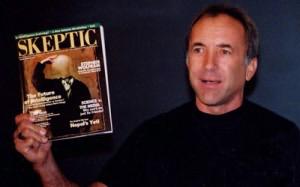
One of Shermer’s favorite sayings is “Skepticism is a method, not a position.” However, I soon discovered that he does not practice what he preaches. In 2003 USA Today published an article about my book The Sense of Being Stared At, describing my research on telepathy and the sense of being stared at. Shermer was asked for his comments and was quoted as saying, “[Sheldrake] has never met a goofy idea he didn’t like. The events Sheldrake describes don’t require a theory and are perfectly explicable by normal means.”
I e-mailed Shermer to ask him what his normal explanations were. But he was unable to substantiate his claim, and he admitted he had not even seen my book. I challenged him to an online debate. He accepted the challenge but said he was too busy to look at the experimental evidence and would “get to it soon.” Several months later he confessed, “I have not gotten to your book yet.” Despite repeated reminders, he has still failed to do so.
It only takes a few minutes to make an evidence-free claim to a journalist. Dogmatism is easy. It is harder work to consider the evidence, and Shermer is too busy to look at facts that go against his beliefs.
In November 2005 Shermer attacked me in his Scientific American “Skeptic” column in a piece called “Rupert’s Resonance.” He ridiculed the idea of morphic resonance by claiming that I proposed a “universal life force,” a phrase I have never used. He also referred to fallacious, partisan claims by other skeptics about my experimental work, which had already been refuted in peer-reviewed journals and even in the Skeptical Inquirer itself.
I wrote a brief letter to Scientific American to set the record straight, but it was not published, nor even acknowledged, and Shermer himself ignored it. Other scientists whom Shermer has misrepresented have had the same experience. The disciplines of science do not seem to apply to media skeptics.
The readers of Scientific American would be better served by a fair and truthful presentation of the facts than by Michael Shermer’s misleading skepticism.
Meanwhile, Shermer continues to flatter himself with fine-sounding words. In 2010 he contrasted his kind of skepticism with denialism, as in climate change denial or holocaust denial or evolution denial: “When I call myself a skeptic, I mean I take a scientific approach to the evaluation of claims…. A climate denier has a position staked out in advance and sorts through the data employing ‘confirmation bias’ — the tendency to look for and find confirmatory evidence for preexisting beliefs and ignore or dismiss the rest. … Thus one practical way to distinguish between a skeptic and a denier is the extent to which they are willing to update their positions in response to new information. Skeptics change their minds. Deniers just keep on denying.”
By Shermer’s own criteria he is a perfect example of a denier.
Lewis Wolpert

In 2001 in a program about some of my telepathy experiments on the Discovery Channel he proclaimed, “There is no evidence for any person, animal, or thing being telepathic.” The director of the documentary offered to show him a video of my experiments so that he could see the evidence for himself, but he was not interested. He preferred to make his skeptical claim without looking at the facts.
In January 2004 Wolpert and I took part in a public debate on telepathy at the Royal Society of Arts in London, with a high court judge in the chair. We were each given thirty minutes to present our cases. Wolpert spoke first and said that research on telepathy was “pathological science” and added, “An open mind is a very bad thing — everything falls out.” He asserted that “the whole issue is about evidence” and concluded after a mere fifteen minutes that “there is zero evidence to support the idea that thoughts can be transmitted from a person to an animal, from an animal to a person, from a person to a person, or from an animal to an animal.”
I then summarized evidence for telepathy from thousands of scientific tests and showed a video of recent experiments, but Wolpert averted his eyes from the screen. He did not want to know. According to a report on the debate in Nature, “few members of the audience seemed to be swayed by [Wolpert’s] arguments. … Many in the audience … variously accused Wolpert of ‘not knowing the evidence’ and being ‘unscientific.'”
For anyone who wants to hear both sides for themselves, the debate is online in streaming audio, as is the transcript.
The European Skeptics Congress
I was invited to speak at the twelfth European Skeptics Congress in Brussels, Belgium, in October 2005. I took part in a plenary session in which there was a debate on telepathy between me and Jan Willem Nienhuys, the secretary of a Dutch skeptic organization, Stichting Skepsis. I presented evidence for telepathy, reviewing research by others and by myself. Nienhuys then responded by arguing that telepathy was impossible, and therefore all the evidence for it must be flawed. He commented that the more statistically significant my experimental results were, the greater the errors must be. I asked him to specify these errors, but he said he could not do so since he had not actually read my papers or studied the evidence.
Here is a description of the debate by an independent observer, Dr. Richard Hardwick, a scientist at the European Commission:
Dr. Sheldrake was on first. … He came well prepared, and he spoke fluently and clearly, as if he really wanted to communicate. He marshaled his arguments with precision, he provided (so far as I can judge) evidence for his statements, and he brought his null hypotheses out into the open, ready to be shot down by the force of disproof. In my judgment, Nienhuys’s counterattack failed. … It seems Dr. Nienhuys had not done his homework. He did not have any data or analyses at hand, and his attack fizzled out. So in the questionnaire that was (commendably) distributed to the participants for filling in afterward, I scored the encounter not “game, set, and match to Sheldrake,” but at least “Sheldrake, 40; Nienhuys, love.” A small cluster gathered around Sheldrake at the end of the Congress. They seemed to be talking with him, rather than pummeling him to the ground, so perhaps they agreed with me.
National Geographic TV Channel
The most flagrant example of a biased presentation of research with animals occurred on the National Geographic Channel in 2005. It was so bad that I complained about it to the British media regulator, the Government Office of Communications (Ofcom), whose duties include ensuring that television companies behave fairly. After considering my case, the response from National Geographic, and viewing the TV show, Ofcom issued an official adjudication ruling that National Geographic had broken the guarantee they had given me to present my research fairly. National Geographic was required to stop transmitting the program and to broadcast a summary of Ofcom’s adjudication. National Geographic appealed against this decision, but the judge rejected all their arguments and upheld Ofcom’s adjudication. Meanwhile, in the United States, National Geographic Channel continued to repeat broadcasts of the offending program, called Is It Real? Psychic Animals.
I was particularly disappointed by National Geographic’s attitude since I had always held the National Geographic Society in high regard. My father subscribed to National Geographic magazine, which I read avidly throughout my childhood. I was a member of the society myself. But National Geographic is now a global brand, and the National Geographic Channel is largely owned by Fox Entertainment Group, part of Rupert Murdoch’s media empire.

Here is a summary of what happened. When I was asked to take part in the program, I was reluctant to do so because I was all too familiar with the debunking format that TV companies used when presenting controversial research. In the standard scenario, someone who had done serious research on unexplained phenomena was called a “proponent” making a “claim,” and then a self-described skeptical investigator, usually with no scientific credentials, disdainfully debunked the claim. When I expressed my doubts the National Geographic producer, Dana Kemp, told me nothing about the involvement of the CSICOP team and replied as follows:
We’re used to the skeptical question — it’s one that comes up a lot, and I understand the concern. Being National Geographic, and having a very strict policy of balanced reporting, we cannot be biased in either direction. It is our job to present the work being done, and where deemed necessary and in all fairness we will often include the flip side of the coin. I will tell you that this is the first show I will be producing for this series, and as the producer I absolutely have no intention of putting anyone in an unfair, uncomfortable position or making anyone look silly. My goal is to present science.
Contrary to these assurances the show was strongly biased toward dogmatic skepticism. The “skeptical investigator” was Tony Youens, a British media skeptic with no scientific credentials; his only qualification was that he was a self-proclaimed skeptic. The National Geographic Channel chose to put the full weight of its authority behind Youens’s misrepresentation of my research, and I was given no opportunity to reply.
The segment of this show on animal telepathy started with me saying that I had tested the African Gray parrot N’kisi and that he appeared to have telepathic powers… N’kisi’s owner, Aimee Morgana, turned down a request to appear because she did not trust National Geographic’s motives. So the National Geographic team did a “counter experiment” with an African Gray called Spaulding. One problem with this test was that Spaulding did not show the same kind of telepathic behavior as N’kisi in the first place. In addition, she was tested under stressful conditions that included being moved from her usual place to another part of the house, with strangers from the TV crew all around her. Predictably, the results were no better than chance.
In order to discredit the research with N’kisi, the narrator and Tony Youens then made misleading claims about the statistical analysis of results in the paper that Aimee Morgana and I published in the Journal of Scientific Exploration. Based on a long series of controlled tests, this paper provided evidence that a parrot was able to respond telepathically to his owner even though she was in a different room on a different floor and he could not see or hear her.
Here is a transcript of the first of Youens’s claims:
Narrator: One could argue that perhaps Spaulding’s poor performance means that she isn’t really telepathic, compared to N’kisi, the bird Rupert Sheldrake tested. But Tony found holes in Sheldrake’s experiment too.
Youens: The thing that bothers me about the Sheldrake experiment is that if the bird didn’t answer, give any credible answer, then they just scrubbed that.
Narrator: Sheldrake threw those trials out completely.
A graphic shows a phrase leaping out of the paper: “They were irrelevant to the analysis.”
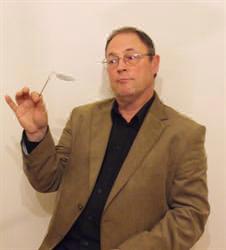
When Youens and the National Geographic producer read our article, they must have known that the omission of the trials in which N’kisi did not respond made no difference. With or without this omission, the results were highly significant statistically. Therefore for them to imply that omitting these trials from the statistical analysis invalidated our results was deliberately misleading.
The program then went on to make a further misleading claim, as follows:
Narrator: And if N’kisi didn’t come up with words she rarely speaks, he threw out those trials as well.
A graphic shows another phrase leaping out of the paper saying: “Exclude the eighteen trials involving these images.”
Youens: That ultimately stacks the deck. There’s no reason he shouldn’t still get them, rare words or not, and you’ve got to include those misses as well as the hits.
A graphic shows our paper shrinking and spiraling down into a black hole, then disappearing into oblivion with a sucking sound.
Here is the passage from our paper from which the seemingly incriminating phrase leaped out:
The list of N’kisi’s vocabulary from which the key words had been chosen was not edited for frequency or reliability of use, and it included some words that N’kisi had used only rarely and did not utter at all during this series of trials. These words were “cards,” “CD,” “computer,” “fire,” “keys,” “teeth,” and “TV.” There were eighteen trials involving pictures corresponding to these words in which N’kisi could not have scored either a hit or a miss, since he never said these words. In established practices for testing language-using animals, the words tested are typically screened in some way for reliability of production. Perhaps a better way of analyzing the results would be to exclude the eighteen trials involving these images. The results of this analysis are shown in Table 4, II. This method reduced the number of misses, and consequently the proportion of N’kisi’s hits increased. For example, by the majority scoring method (B), 23 words out of 82 were hits (28 percent). Nevertheless, this method made little difference to the statistical significance of the results, as shown by a comparison of parts I and II of Table 4.
Table 4, I shows the results including all key words, and part II shows what happens when the eighteen trials are omitted. There is practically no difference. For example, comparing IC with IIC, the p-values arrived at by a randomized permutation analysis are 0.002 and 0.003 respectively, both values being highly significant.
Thus for the narrator and Youens to claim that our analysis of the data was invalid because we omitted rarely said words is deceitful. We were contrasting this method with an all-inclusive method, which we carried out first. Our main conclusions, quoted in the program, were from the all-inclusive method. In other words we showed that the omission of rare words made practically no difference. Our results were highly significant statistically whatever method of analysis we used. The points Youens raised were all fully addressed in our paper. National Geographic knew this, and they deliberately misled viewers in a way that gave a damaging and false impression of our work.
I was given no chance to respond to Youens’s comments, but National Geographic’s lawyers still claimed that the program “presents the views of each of the parties fairly and in a balanced, professional manner.” I alerted other researchers on unexplained phenomena to National Geographic’s concept of fairness and advised them to treat any approaches from National Geographic Channel with extreme caution.
A review of the entire Is It Real? series by Ted Dace, an independent commentator, helps put this incident in its wider context: “The object of Is It Real? is to place its viewers under the purring, hypnotic sway of Science, not science as a method for obtaining reliable knowledge but scientism as a kind of religion that casts out the demons of uncertainty and mystery. Each episode in the series raises the specter of the paranormal only to reveal it as the hallucination of abnormal people. Backed up by a battalion of skeptical commentators … Is It Real? presents a black and white world of skeptics and believers, and the skeptics turn out to be right every time.”
Richard Dawkins
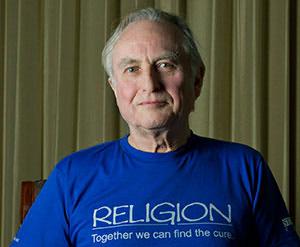
Soon before Enemies of Reason was filmed, the production company IWC Media told me that Richard Dawkins wanted to visit me to discuss my research on unexplained abilities of people and animals. They did not tell me that the series was to be called Enemies of Reason. I was reluctant to take part because I expected that it would be as one-sided as Dawkins’s previous series, and I had already had several negative experiences with TV companies promoting a skeptical agenda, including National Geographic. But the production team’s representative, Rebecca Frankel, assured me that they were open-minded, adding, “This documentary, at Channel 4’s insistence, will be an entirely more balanced affair than The Root of All Evil? was.” She told me, “We are very keen for it to be a discussion between two scientists, about scientific modes of inquiry.” On the understanding that Dawkins was interested in discussing evidence, and with the written assurance that the material would be edited fairly, I agreed to meet him and we fixed a date.
I was still not sure what to expect. Was he going to be dogmatic, with a mental firewall that blocked out any evidence that went against his beliefs? Or would he be fun to talk to?
Dawkins duly came to call. The Director, Russell Barnes, asked us to stand facing each other; we were filmed with a handheld camera. Dawkins began by saying that he thought we probably agreed about many things, “But what worries me about you is that you are prepared to believe almost anything. Science should be based on the minimum number of beliefs.”
I agreed that we had a lot in common, “But what worries me about you is that you come across as dogmatic, giving people a bad impression of science, and putting them off.”
Dawkins then said that in a romantic spirit he himself would like to believe in telepathy, but there just wasn’t any evidence for it. He dismissed all research on the subject out of hand, without going into any details. He compared the lack of acceptance of telepathy by scientists such as himself with the way in which the echolocation system had been discovered in bats, followed by its rapid acceptance within the scientific community in the 1940s. In fact, as I later discovered, Lazzaro Spallanzani had shown in 1793 that bats rely on hearing to find their way around, but skeptical opponents dismissed his experiments as flawed and helped set back research for more than a century. However, Dawkins recognized that telepathy posed a more radical challenge than echolocation. He said that if it really occurred it would “turn the laws of physics upside down,” and added, “Extraordinary claims require extraordinary evidence.”
“This depends on what you regard as extraordinary,” I replied. “The majority of the population say they have experienced telepathy, especially in connection with telephone calls. In that sense, telepathy is ordinary. The claim that most people are deluded about their own experience is extraordinary. Where is the extraordinary evidence for that?”
He could not produce any evidence at all, apart from generic arguments about the fallibility of human judgment. He also took it for granted that people want to believe in the paranormal because of wishful thinking.
We then agreed that controlled experiments were necessary. I said that this is why I had actually been doing such experiments, including tests to find out if people really could tell who was calling them on the telephone when the caller was selected at random. The results were far above the chance level. The previous week I had sent Dawkins copies of some of my papers in scientific journals so that he could examine some of the data before we met. At this stage he looked uneasy and said, “I don’t want to discuss evidence.” “Why not?” I asked. He replied, “There isn’t time. It’s too complicated. And that’s not what this program is about.” The camera stopped.
Russell Barnes confirmed that he too was not interested in evidence. The film he was making was another Dawkins polemic against irrational beliefs. I said to him, “If you’re treating telepathy as an irrational belief, surely evidence about whether it exists or not is essential for the discussion. If telepathy occurs it’s not irrational to believe in it. I thought that’s what we were going to talk about. I made it clear from the outset that I wasn’t interested in taking part in another low-grade debunking exercise.”
Dawkins said, “It’s not a low-grade debunking exercise; it’s a high-grade debunking exercise.” I replied that in that case there had been a serious misunderstanding, because I had been assured that this was to be a balanced scientific discussion about evidence. Russell Barnes asked to see the e-mails I had received from his assistant. He read them with obvious dismay and said the assurances she had given me were wrong. The team packed up and left.
Richard Dawkins has long proclaimed his conviction that “The paranormal is bunk. Those who try to sell it to us are fakes and charlatans.” Enemies of Reason was intended to popularize this belief. But does his crusade really promote the public understanding of science, of which he was the professor at Oxford? Should science be a vehicle of dogma and prejudice, a kind of fundamentalist belief system? Or should it be based on open-minded inquiry into the unknown?
Skeptical Revivalism
The skeptic movement is closely allied to evangelical atheism, and since the turn of the millennium both have undergone a resurgence. One of the most influential figures in this social movement is James Randi, who is greatly admired by Richard Dawkins and other crusading atheists. For the 2009 relaunch of the British Skeptic magazine, published by CSICOP/CSI, the cover story was on Randi, and the editor, Chris French, introduced his interview with Randi by writing, “If skeptics were allowed to have patron saints, James Randi would undoubtedly fill that role.”
Skeptics admire Randi’s belligerent style and his tireless activism in the skeptical cause. Since 2003 he has held an annual gathering of skeptics and atheists in Las Vegas called “The Amazing Meeting,” which is like a revivalist rally. Inspirational speakers have included Richard Dawkins, Richard Wiseman, and Michael Shermer. Participants are not just motivated but taught the tricks of the trade. For example, in the 2005 meeting Randi and Shermer gave a seminar entitled “Communicating Skepticism to the Public: A Seminar on Promoting a Scientific View of the World.” Attendees were handed a manual that told them how to be a media skeptic: “Becoming an expert is a pretty simple procedure; tell people you’re an expert. After you do that, all you have to do is maintain appearances and not give them a reason to believe you’re not.”
In real science becoming an expert requires qualifications and hard work, but as Randi and Shermer pointed out the rules are different for skeptics. All you need is to form a club with like-minded people: “As head of your local skeptic club, you’re entitled to call yourself an authority. If your other two members agree to it, you can be the spokesperson too.”
Neither Randi nor Shermer are scientists, and their “scientific view of the world” is a fundamentalist belief system rather than science itself. For decades skeptics have gotten away with deceit, dishonesty, and ignorance by laying claim to the authority of science. Those who disagree with them can then be labeled as ignorant and irrational. But if skeptics want to be taken seriously, then they should be subject to the same kinds of quality control as genuine scientists. In the long term, the cause of science and reason will not be advanced by their unscientific and unreasonable behavior.
Skeptical Credulity
Although committed skeptics see themselves as devoted to science, reason, and critical thinking, they are credulous when it comes to the claims of other skeptics. Many science correspondents share this credulity, which is why the scientific media tend to endow dogmatic skepticism with an authority it does not deserve. For example, when prominent materialists like Lewis Wolpert assert that there is no evidence for telepathy, they are quoted uncritically in newspapers and television shows, as if they know what they are talking about. In fact, they are willfully ignorant of the evidence and are merely expressing their prejudices. They abuse their scientific authority.
The effect of skeptical credulity on science is profound. The great majority of universities neither teach about psychic research or parapsychology nor support research in this field. Since students and professional scientists are not informed about research on these subjects, they are ill-equipped to evaluate the claims of skeptics, and they often take what little information they have from skeptic websites or skeptical propaganda in the media. Serious journalists generally share the prejudices of dogmatic skeptics, or at least defer to them in public for fear of being attacked as ignorant and unscientific. The same is true of most politicians. The result is that there is no public funding for research in these controversial areas.
Meanwhile the popular interest in psychic phenomena is encouraged by downmarket media, reinforcing the belief of skeptics that people who take these phenomena seriously are stupid, ignorant, or deluded.
Skeptical organizations play a useful role in exposing fraudulent psychics and charlatans. But insofar as they inhibit scientific research and inquiry into the unknown, they set back the cause of science and reason rather than promoting it. The present system of science funding reinforces the status quo.
Open-Minded Science
Until the early twentieth century, some of the most innovative scientists were amateurs; they did science because it interested them, not because it was a career. Charles Darwin was a striking example. Science is now almost completely institutionalized and professionalized. Career scientists generally lack independence; few can follow their curiosity where it leads. They depend on government, institutional or corporate funding. Their grant applications are peer-reviewed anonymously and committees make the decisions, with the result that caution predominates, and unconventional proposals are passed over in favour of safer, more predictable ones.
Taxpayers fund most of the scientific research carried out in universities and research institutes, but they have almost no say in what gets done. Committees of influential scientists, politicians, and corporate executives determine the priorities. In biology, for example, billions of dollars are spent on sequencing genomes, with results of interest only to a handful of specialists. Meanwhile, there is little or no funding for investigating the topics discussed in this book, such as the ability of animals to give warnings of earthquakes and tsunamis, despite that fact that this research would interest millions of people and might be very useful.
My own proposal for a moderate reform of science funding is that 1 percent of the science budget would be allocated to areas of research proposed by nonprofessionals. The other 99 percent of the funds would be spent as usual. Organizations such as charities, schools, societies, small businesses, and environmental groups would be invited to suggest questions they would like to see answered by research. Within each organization, the very possibility of having a say would probably trigger far-ranging discussions and lead to a sense of involvement. For the first time, an element of democracy would play a part in science. This system could be treated as an experiment and tried out for, say, five years. If it had no useful effects it could be discontinued. If it led to productive research, greater public trust in science, and increased interest among students, the percentage allocated to this fund could be increased.
There are few fields of science today where people outside institutional science can do exciting, hands-on research. But professional scientists have neglected most of the subjects covered in this book, and as a result this field of study is extraordinarily underdeveloped, like the study of magnetism in the seventeenth century, fossils in the eighteenth century, and genetics at the time of Mendel. Precisely because this is a field of inquiry in its infancy, there are remarkable opportunities for original investigations on very low budgets.
Digital discoveries
- Casino Non AAMS
- Siti Casino
- Sites De Paris Sportifs Belgique
- Tous Les Sites De Paris Sportifs Belgique
- Meilleur Casino En Ligne Belgique
- I Migliori Casino Online
- Non Aams Casino
- Migliori Casino Online Esteri
- Paris Sportif Crypto Sans Kyc
- Paris Sportif Ufc
- Casino Live En Ligne Français
- Site De Paris Sportifs
- Meilleurs Nouveaux Casinos En Ligne
- Casino En Ligne Français
- Casino En Ligne
- Casino Retrait Instantané
- Casino En Ligne Retrait Immédiat



